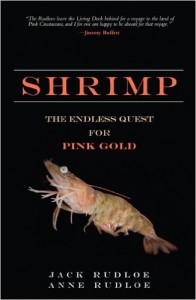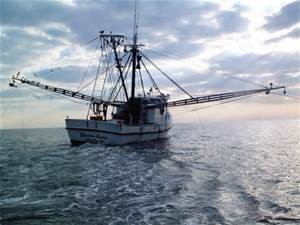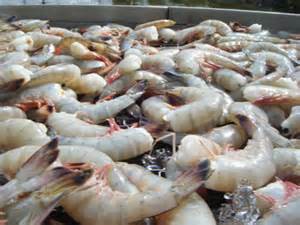Shrimp… nothing says seafood along the Gulf coast like shrimp. It has been a staple part of our diet for decades; boiled, fried, steamed, stuffed, shish-kabobbed, As Forrest Gump said there are a million ways to cook shrimp and as Jack and Anne Rudloe mention their book, Shrimp, the Endless Quest for Pink Gold, there are many cookbooks dedicated to preparing one of the most popular seafood species.

Growing up in Pensacola I remember the shrimp boats lining Palafox Street at the Bayfront Auditorium. You could drive down with your cooler almost any day and purchase white or brown shrimp for $2-3 a pound. The boats were beautifully painted with red and blue colors. Their coolers were full and we would fill ours, take them home, de-head them, and then have to decide how we wanted to prepare them… fry? Shrimp and grits? Boiled? They were college football tail gating food, birthday celebrations, and I cannot remember a wedding reception I went to, including my own, where shrimp was not served in some form or fashion. It’s a great product, taste great, and good for you. Bu things are changing…
Locals along the panhandle might be surprised that shrimping, as we know it, did not begin here. Many who think of “shrimping” immediately think of Louisiana, Mississippi, and Alabama. Old wooden boats with nets draped everywhere and the familiar sound of the diesel engine in the early morning silence as they bring in the evenings catch. But according to the Rudloe’s commercial shrimping began in California. In their book they describe the evolution of the shrimping industry. Shrimp were in abundance in early human history, and relatively easy to catch. Archeologists assume they consumed large quantities of them but their chitonous shells do not preserve well so we are not sure. There are preserved nets from that time period which probably captured shrimp along with other small nearshore species. They were harvested in Europe, Africa, and certainly Asia using both nets and traps.
As these cultures came to the New World they brought with them the methods of capturing. Native Americans too used weirs and traps to collect. But it was Chinese who came to San Francisco during the gold rush that brought the idea of pulling nets behind their Chinese Junks and small shrimping villages began to pop around the Bay area. Though Cajuns had been shrimping in the Gulf before the Declaration of Independence was signed using beach seines, trawling behind boats did not come until later. At first these earlier shrimpers used sailing schooners and hauled the nets by hand but eventually the internal combustion engine arrived and both boat and winch power made the job easier and they could stay our longer. Dried shrimp was how the product was sold at first but the introduction of refrigeration meant shrimp could be brought in fresh, and the laundry list of how to prepare began. The amount of shrimp demanded stronger vessels, they switched from wood to steel and fiberglass vessels, and stronger power to pull these large nets, and they switched to diesel. With better vessels and power they could drop more than one net, shrimp boats were now seen with double booms and they could move farther offshore.

Photo: NOAA
There are literally thousands of different species of shrimp in the world’s oceans but only a few are collected for food. In some cultures the small inshore species are the targets. Today some prefer the deep water ruby reds that could be collected only when the technology allowed. But most of us prefer shrimp from the Family Penaidae. White shrimp (gulf shrimp – Litopenaeus setiferus), brown shrimp (bay shrimp, “brownies” – Farfantepennaeus aztectus), and the pink shrimp (Farfantepenaeus duorarum) are the species locals enjoy. 90% of these three species sold are harvested from the Gulf of Mexico supporting, in some cases, whole communities. Then things began to turn “south”…
According to NOAA’s Fishwatch.gov the fishery is not currently being overfished. The problem with today’s shrimping industry is economic and environmental.

Photo: North Carolina State University
Economically, the cost of diesel has increased and for a 12,000 gallon vessel can cost the fishermen $50,000 per trip.
Bartering with wholesalers, many shrimpers will make 45% of their annual income in the first 45 days of the shrimping season, making tough times down the road – literally a “boom-bust” business.
Aquaculture… farmed raised shrimp has been around for centuries and the increased demand for the product many have turned to farmed shrimp to keep cost down. Many will be surprised to learn that 80-90% of the seafood consumed in the United States is farmed product from overseas. These low prices are difficult for the traditional ocean harvesting shrimper to compete with. You may also not know that a large amount of the product farmed overseas is not allowed to enter into the United States because of their method of using hormones to accelerate growth.
Environmentally, the trawl… As they drag their nets across the bottom they remove a lot of marine life in addition to the target species of shrimp. The otter trawl is opened using wooden doors and is pulled along the bottom using a chain (known as a “tickler”) to force the buried nocturnal shrimp to “pop up”. Trawled over seagrass beds they can do a lot of damage. Some studies have shown that almost 60% of the catch is what has been termed “trash fish” or “by-catch”. The Ocean Conservancy reports that after the World War II, when technology significantly improved for shrimpers, the by-catch to shrimp ratio was 4:1. Pressure from environmental groupers and other fisheries forced regulations on when, where, and how trawling would occur in attempts to reduce by-catch and damage to sensitive bottom habitat.
Sea turtles… one of the by-catch species were the federally protected marine turtles. This forced a change that required a Turtle Excluder Device (TEDS) to be installed into the trawl.
The oil spill… shrimpers certainly suffered from this incident and 10 years later in many parts of the Gulf the problems still exist.
We of course cannot forget “Mother Nature”. Hurricanes can change the ecology of the system enough to decrease available shrimp for several years.

Photo: Mississippi State University
All in all these economic and environmental issues have forced many out of the business. A few years ago the shrimping fleet in Pensacola numbers between 40 and 50 vessels, today there are about 10. Times are hard on the traditional shrimper… but despite these setbacks it still remains one of the more popular seafood species.
 0
0
